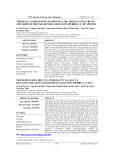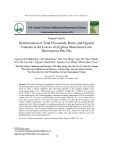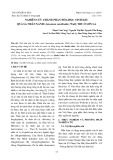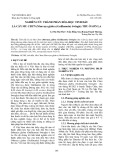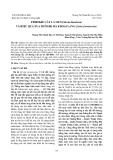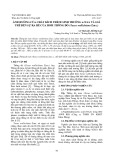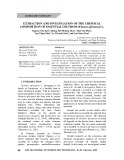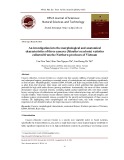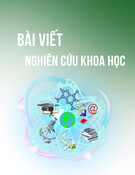Tạp chí phân tích Hóa, Lý và Sinh học - Tập 30, số 02/2024
ISOLATION OF FLAVONOIDS FROM LEAVES OF CARALLIA BRACHIATA Đến tòa soạn 01-06-2024 Trinh Thi Thanh Van, Nguyen Hoang Nam, Tran Van Hieu, Vu Van Nam, Le Nguyen Thanh, Tran Hong Quang, Pham Van Cuong, Nguyen Quoc Vuong* Institute of Marine Biochemistry, Vietnam Academy of Science and Technology, Ha Noi, Viet Nam * Email: nguyenvuong@imbc.vast.vn TÓM TẮT
PHÂN LẬP MỘT SỐ HỢP CHẤT FLAVONOID
TỪ LÁ LOÀI XĂNG MÃ (CARALLIA BRACHIATA MERR.) Từ dịch chiết ethyl acetate của lá loài Xăng mã (Carallia brachiata Merr.), một số hợp chất flavonoid gồm (+) - catechin (1), (-) - catechin (2), catechin 3-O-α-L-rhamnopyranoside (3), chrysoeriol (4) và engeletin (5) đã được phân lập. Cấu trúc của chúng đã được xác định dựa trên sự phân tích phổ cộng hưởng từ hạt nhân (NMR) và phổ khối (ESI-MS) và so sánh với tài liệu. Đây là lần đầu tiên những flavnoid (2-5) trên được phân lập từ chi Carallia cũng như từ loài Xăng mã.
Keywords: Flavonoid, catechin, chrysoeriol, engeletin, Xăng mã (Carrallia brachiata Merr.).
1. INTRODUCTION
resolution of structure
(3), one
compounds such as catechin and epicatechin. Despite low oral bioavailability, most polyphenols proved significant biological effects [7]. They were evaluated as affected biochemical and antioxidant agents used to treat various diseases such as cardiovascular, neurodegenerative and cancer [8, 9]. In this paper, we reported the isolation and five flavonoids including three flavan-3-ol compounds, (+)-catechin (1), (-)- catechin (2), and catechin 3- flavone, O-α-L-rhamnopyranoside chrysoeriol (4) and one flavononol, engeletin (5) from leaves of C. brachiata Merr.
MATERIALS AND 2. RESEARCH METHODS
2.1. General experimental procedures
1H-NMR, 13C-NMR, and 2D-NMR spectra were recorded on a Bruker AM500 FT-NMR spectrometer using TMS as an internal standard. The electrospray ionization mass spectra (ESI- MS) were measured on an Agilent 1100 Series
Carallia brachiata Merr. is a flower plant (Vietnamese name is “Xang ma, Truc tiet”) belonging to the family Rhizophoraceae. This plant has been used as a folk medicinal plant in Vietnam for treatment of tongue sores, mouth ulcers, malaria and sore throats [1,2]. In the world, chemical investigations of this plant have shown megastigmanes, aromatic compounds, condensed tannins, flavonoids, and glyceroglycolipids from it [3]. Bioactives of this plant were also reported as anti-inflamatory [4] and antimicrobial activity [5]. In Vietnam, chemical studies on this plant have been still limited. Therefore, in our project, we recently reported, from leaves of C. brachiata, two new catechin derivatives (carabrachiatanins A and B) and seven known proanthocyanidins were isolated and their anti-inflammatory activity was evaluated by inhibition of NO production in RAW264.7 cells [6]. As it was known, the proanthocyanidins were oligomeric flavonoids, many of which were oligomers of flavan-3-ol
57
high-performance
four fractions (CE1.2.1.1- CE1.2.1.4). Fraction CE1.2.1.2 was purified by HPLC with MeOH/H2O (1/2, v/v) to give compound 1 (15 mg). Fraction CE1.2.3 was further purified by sephadex LH-20 CC eluting with MeOH to give five sub-fractions (CE1.2.3.1- CE1.2.3.5). Fraction CE1.2.3.2 was purified by HPLC with MeOH/H2O (1/2, v/v) to give compound 2 (7.5 mg). Fraction CE1.2.3.4 was chromatographed by RP-18 CC eluting with MeOH/H2O (1/2) to yield compound to give compound 3 (2.7 mg).
LC/MSD Trap SL. Column chromatography (CC) was performed using silica gel 60 (230 - 400 mesh, Merck) or RP-18 resin (30 - 50 μm, Fuji Silysia Chemical Ltd., Aichi, Japan). Semi- preparative liquid chromatography (HPLC) were performed on an Agilent 1260 system including binary pump, autosampler, DAD detector, and semi-preparative HPLC column YMC J'sphere ODS-H80 (4 µm, 20 × 250 mm) with isocratic mobile phase at the flow rate of 2.5 mL/min used in Semi-prep-HPLC. The compound was monitored at wavelengths of 205, 230, 254, and 280 nm. Optical rotations were recorded on a JASCO P-2000 Polarimeter. Thin layer chromatography used precoated silica gel plates (Merck 60 F254).
The fraction CE4 was chromatographed by RP-18 CC eluting with MeOH/H2O (1/4) to give five fractions (CE4.1-CE4.5). Fraction CE4.2 (27 g) was further purified by sephadex LH-20 CC eluting with MeOH to give compounds 4 (9.3 mg) and 5 (5.6 mg). 2.2. Plant materials
(CD3OD, 500 MHz) and + 17 (c 0.1, (+)-Catechin (1): yellow solid, MeOH). Negative ESI-MS: m/z 290 [M]−. 1H- 13C-NMR NMR (CD3OD, 125 MHz) see Table 1.
Leaves and branches of Carallia brachiata Merr. were collected in Trieu Son, Thanh Hoa in March 2021 and identified by Dr Do Van Hai at Institute of Ecology and Biological Resources, VAST. The specimen (VAST.04.02/22-23) was kept at Institute of Marine Biochemistry, VAST.
2.3. Extraction and isolation (CD3OD, 500 MHz) and (−)-Catechin (2): yellow solid, − 49 (c 0.1, MeOH). Negative ESI-MS: m/z 290 [M]−. 1H- 13C-NMR NMR (CD3OD, 125 MHz) see Table 1.
Catechin 3-O-α-L-rhamnopyranoside (3) yellow
− 21 (c 0.1, MeOH). Negative ESI- solid, MS: m/z 435 [M]−. 1H-NMR (CD3OD, 500 MHz) and 13C-NMR (CD3OD, 125 MHz) see Table 1.
The C. brachiata (2.5 kg of the dried leaves) was pulverized then extracted with 85% MeOH (10 L × 4) by sonification at 50 °C for each time 2 h. The extracts were combined, and MeOH were removed in reduced pressure to give a crude MeOH extract (1.2 L). The MeOH extract was suspended with water (1.2 L) and successively partitioned with n-hexane and ethyl acetate (EtOAc) gave n-hexane (CH, 21.5 g) and ethyl acetate (CE, 72.0 g) residues and a water layer (CW, 1.5 L). − 23 (MeOH; Chrysoeriol (4): yellow solid, c 0,1). ESI-MS: m/z 301 [M+H]+. 1H-NMR (CD3OD, 500 MHz) and 13C-NMR (CD3OD, 125 MHz) see Table 2.
The AFE residue was chromatographed on a silica gel CC eluting with EtOAc to give five fractions (fr. CE1–CE5). Engeletin (5): yellow solid. ESI-MS: m/z 435 [M]−. 1H-NMR (CD3OD, 500 MHz) and 13C- NMR (CD3OD, 125 MHz) see Table 2.
3. RESULTS AND DISCUSSION
structure of isolated compounds was The described in Figure 1.
further Fraction CE1 was chromatographed on a silica gel column eluting with n-hexane/EtOAc (1/1, v/v) to give five sub-fractions (CE1.1–CE1.5). The sub- fraction CE1.2 was chromatographed on a silica gel CC eluting with CH2Cl2/acetone (10/1, /v) to afford four fractions (CE1.2.1–CE1.2.4). Fraction CE1.2.1 was chromatographed on sephadex LH-20 CC eluting with MeOH to give Compound 1 was isolated as yellow solid. The 1H-NMR spectrum of 1 (Table 1) showed signals of two doublets of two meta coupling aromatic protons of the ring A at δH 5.93 (d, J = 2.2 Hz, H-
58
the
28.6 (C-4). The HMBC correlations (Figure 2) between H-2 and C-4/C-3/C-1′/C-9/C-2′/C-6′; H- 3 and C-1′/C-10; H-4ax and C-3/C-2/C-10/C-9/C- 5, H-4eq and C-3/C-2/C-10 indicated that these protons we re located at C-2, C-3, and C-4, respectively. Furt her mo re , the correlations between H-6 and C-5/C-8, H-8 and C-6/C-9/C- 10, presented that two protons are located at C-6 and C-8, respectively. Above 1D and 2D NMR spectroscopic analysis of 1 and comparison with literature [10] identified compound 1 to be a catechin. The large coupling constant (J = 7.5 Hz) of H-2 with H-3 and resonance position of C-2 at δc 82.8 ppm showed the 2,3- trans configuration of 1. The optical rotation of (C-6′); 1 was determined to be +17 (c 0.1, 6) and δH 5.84 (d, J = 2.2 Hz, H-8; three ABX system aromatic protons of ring B at δH 6.82 (d, J = 1.6 Hz, H-2′), 6.75 (d, J = 8.0 Hz, H-5′), and 6.74 (dd, J = 1.6, 8.0 Hz, H-6′); and signals of C ring were observed with two oxymethine groups at δH 4.55 (d, J = 7.5 Hz, H-2) and 3.96 (m, H-3), and a methylene group at δH 2.84 (dd, J = 5.6, 16.0 Hz, H-4eq) and 2.49 (dd, J = 8.0, 16.0 Hz, H-4ax). The 13C-NMR (Table 1) and DEPT spectra showed signals of fifteen carbons including seven non-protonated carbons at δc 157.6 (C-5), 157.8 (C-7), 156.9 (C-9), 146.2 (C- 3′, C-4′), 100.8 (C-10) and 132.2 (C-1′); five methines at δc 96.2 (C-6), 95.4 (C-8), 115.2 (C- two (C-5′) and 120.0 2′), 116.0 oxygenated aliphatic methines at δc 82.9 (C-2) and 68.8 (C-3); and one aliphatic methylene at δc MeOH), establishing 1 to be (+)-catechin.
Figure 1. Chemical structures of compounds 1–5
3), and two protons of a methylene group at δH 2.87 (dd, J = 5.4, 16.2 Hz, H-4eq) and 2.53 (dd, J = 8.4, 16.2 Hz, H-4ax), of C ring. The 1D, 2D NMR spectra analysis of 2 and comparision with literature [10] (Table 1 and Figure 2) also established compound 2 to be a catechin. The large coupling constant (J = 7.5 Hz) of H-2 with H-3 and the resonance position of C-2 at δC 82.9 confirmed 2,3-trans configuration. The optical
rotation of 2 was determined to be − 47 (c
Compound 2 was isolated as yellow solid. Similar compound 1, the 13C-NMR spectra of 2 (Table 1) gave signals of a flavanol with 15 carbons of 3 rings A, B and C including seven non-protonated carbons, five methines, two oxygenated aliphatic methines and one aliphatic methylene. The 1H - NMR spectra of 2 (Table 1) also showed two meta coupling aromatic protons of A ring, three ABX system aromatic protons of B ring. Two protons of two oxymethine groups at δH 4.59 (d, J = 7.5 Hz, H-2) and 4.00 (ddd, 5.5, 7.5, 8.0 Hz, H- 0.1, MeOH), confirmed 2 to be (−)-catechin.
59
rhamnose
sugar by recognisable signals shown including one anomeric carbon at δC 102.1 (C-1″) with anomeric proton at δH 4.32 (d, J = 1.2 Hz, H-1″); four oxygenated methines at δC 72.0 (C-2″)/δH 3.54 (dd, J = 1.2, 3.0 Hz, H-2″), δC 72.3 (C-3″)/δH 3.60 (dd, J = 3.0, 9.0 Hz, H-3″), δC 74.0 (C-4″)/ δH 3.33 (m, H-4″) and δC 70.3 (C-5″)/ δH 3.70 (m, H-5″ ); and one methyl at δC 17.9 (C-6″)/1.27 (d, J = 6.0 Hz, H-6″). The HMBC correlation (Figure 2) between H-1″ and C-3 showed sugar moiety linked to aglycone at C-3. The small coupling constant between H-1″ and H-2″ (J = 1.2 Hz) confirmed α-orientation of sugar moiety. Above 1D, 2D NMR spectra analysis compound 3, and comparison with literature [11] established compound 3 to be catechin 3-O-α-L- rhamnopyranoside.
Compound 3 was isolated as yellow solid. The ESI-MS spectrum gave a negative quasi-molecular ion peak at m/z 435 [M-H]− (C21H23O10) and 13C- NMR spectrum of 3 indicated a molecular formula of C21H24O10 (M = 436). The 1D (Table 1) and 2D NMR spectroscopic analysis of 3 revealed compound 3 to a flavanol glycosis. Moiety similar flavanol was a catechin aglycone compound 1 and 2 with signals of three rings system A, B and C. The proton signals of C ring were shown including two oxymethine groups at δH 4.64 (d, J = 7.8 Hz, H-2) and 3.96 (ddd, 5.4, 7.8, 8.4 Hz, H-3), and two protons of a methylene group at δH 2.90 (dd, J = 5.4, 16.2 Hz, H-4eq) and 2.66 (dd, J = 8.4, 16.2 Hz, H-4ax). The large coupling constant (J = 7.8 Hz) of H-2 with H-3 together the resonance position of C-2 at δC 81.1 confirmed 2, 3-trans configuration. The glycol moiety were identified to be a rhamnose
Table 1. The 1H, 13C-NMR spectroscopic data of compounds 1-3 1 2 3
No. δC ppmc, d δC ppmc, d δH ppmc, e (mult., J= Hz) δC ppma, g δC ppma, b [10] δC ppma, f [11] δH ppma, h (mult., J= Hz) δC ppma, b [10]
82.8 82.9 82.8 82.9 4.59 (d, 7.5) 80.2 81.1 4.64 (d, 7.8) 2 δH ppmc, e (mult., J= Hz) 4.55 (d, 7.5)
68.4 68.8 3.96 (m) 68.3 68.8 74.5 75.9 3
28.8 28.6 28.8 28.5 27.6 27.9 4
4.00 (ddd, 5.5, 7.5, 8.0) 2.53 (dd 8.4, 16.2) 2.87 dd (5.4, 16.2) - 3.96 (ddd, 5.4, 7.8, 8.4) 2.66 (dd, 8.4, 16.2) 2.90 (dd, 5.4, 16.2) - 157.2 157.5 157.0 157.5 5 157.1 157.6
96.1 96.3 5.88 d (2.4) 95.4 96.4 5.96 (d, 2.4) 6 96.2 96.2
157.7 157.8 - 157.6 157.9 - 7 157.6 157.8
95.3 95.5 5.95 d (2.4) 96.4 95.5 5.88 (d, 2.4) 8 95.5 95.4
156.9 100.6 131.8 156.9 100.8 132.2 - - - 156.5 100.2 131.6 156.9 100.7 132.0 - - - 156.7 100.7 132.3 156.9 100.8 132.2 9 10 1ʹ
115.2 115.3 6.86 d (1.8) 114.9 115.1 6.86 (d, 1.8) 115.3 115.2 2ʹ
146.1 146.0 146.2 146.3 - - 145.6 145.7 146.4 146.2 - - 145.6 145.7 146.2 146.2 3ʹ 4ʹ
115.7 116.0 115.7 116.1 6.78 d (8.4) 115.8 116.1 6.79 (d, 7.8) 5ʹ
120.1 120.0 118.8 119.8 119.6 119.8 6ʹ 2.49 (dd, 8.0, 16.0) 2.84 (dd, 5.6, 16.0) - 5.93 (d, 2.2) - 5.84 (d, 2.2) - - - 6.82 (d, 1.6) - - 6.75 (d, 8.0) 6.70 (dd, 1.6, 8.0) 6.74 dd (1.8, 8.4, 1.8) 6.74 (dd, 1.8, 7.8)
60
- - - - - - 101.2 102.1 4.32 (d, 1.2) 1ʺ
- - - - - - 71.5 72.0 2ʺ
- - - - - - 72.2 72.3 3ʺ
- - - - - - - - - - - - - - - - - - 73.6 69.6 18.0 3.54 (dd,1.2, 3.0) 3.60 (dd,3.0, 9.0) 74.0 3.33 (m) 70.3 3.70 (m) 17.9 1.27 (d, 6.0) 4ʺ 5ʺ 6ʺ
Recorded in a,acetone-d6 at b,125 MHz, c,CD3OD, d,100 MHz, e,500 MHz, f25.05 MHz, g150 MHz, h600 MH
Figure 2. Key HMBC correlations of catechin (1 and 2) and 3
301[M+H]+ (C16H13O6+) was observed, together 13C-NMR spectrum of 4 determined a molecular formula of 4 t o b e C16H12O6 (M = 300). The analysis of ESI-MS and NMR spectra of 3 and comparison with those reported in literature [12] identified compound 4 to be chrysoeriol (3′- methoxy-4′, 5, 7-trihydroxyflavone).
Compound 4 was isolated as a yellow solid. 1H- NMR spectrum of compound 4 (Table 2) exhibited signals of a flavone including two meta coupling aromatic protons of A ring at δH 6.55 (d, J = 1.9 Hz, H-8) and δH 6.26 (d, J = 1.9 Hz, H-6); three ABX coupling aromatic protons of B ring at δH 7.61 (d, J = 2.0 Hz, H-2′), 7.57 (dd, J = 2.0, 8.2 Hz, H-6′) and 7.00 (d, J = 8.2 Hz, H- 5′); and one methine aromatic proton of C ring at δH 6.69 (s, H-3). The 1 3C-NMR (Table 2) and DEPT spectra indicated signals of fifteen carbons including one carbonyl at δC 183.2 (C-4); eight non-protonated carbons at 163.4 (C-5), 165.1 (C- 7), 158.8 (C-9), 148.9 (C-3′), 151.4 (C-4′), 165.0 (C-2), 105.2 (C-10) and 123.5 (C-1′); and six methines at δH 99.7 (C-6), 94.8 (C-8), 110.5 (C- 2′), 116.5 (C-5′), 121.4 (C-6′) and 104.5 (C-3). Furthermore, the HMBC correlations between H-3 and C-1′/C-2/C-4/C-10 and between H-8 and C- 6/C-7/C-9/C-10 determined two protons at C-3 and C-8, respectively; between H-6′ and C-2′/C- 4′/C-2 and between protons of OCH3 and C-3′(δC 148.9) identified the methoxy group located on position C-3′of B ring. On the ESI-MS of 4, a ion peak at m/z positive quasi-molecular Compound 5 was isolated as a yellow solid. The 1D and 2D NMR spectroscopic analysis (Table 2) of 5 shown compound 5 to a flavanonol glycosis. aglycone compounds 1-3, moiety Similar flavanonol of is three rings system A, B and C with a methylene at C-4 oxidated to a cetone group (4-C=O). The 1H-NMR spectrum of compound 5 showed signals of a flavanonol with two meta coupling aromatic protons of A ring at δH 5.94 (d, J = 2.4 Hz, H-8) and δH 5.91 (d, J = 2.4 Hz, H-6); four protons of the 1,4-substituted aromatic B ring at δH 7.37 (d, J = 9.0 Hz, H-2′, H-6′ ), 6.86 (d, J = 9.0 Hz, H-3′, H-5′); and two protons of oxymethine groups of C ring at δH 5.15 (d, J = 10.8 Hz, H-2) and δH 4.63 (d, J = 10.8 Hz, H-3). The large coupling constant of H-2 with H-3 determined 2,3-trans configuration. The 13C- NMR and DEPT spectra exhibited signals of a
61
anomeric proton at δH 4.04 (d, J = 1.2 Hz, H-1″); four oxygenated methines, and one methyl. The HMBC correlation between H-1″ and C-3 revealed sugar moiety linked to aglycone at C-3. The small coupling constant between H-1″ and H- 2″ (J = 1.2) determined α-orientation of rhamnoside sugar moiety. Above 1D, 2D NMR spectra analysis compound 5 and in comparison with literature [13], determined compound 5 to be engeletin. to be a signals shown flavanonol with fifteen carbons including one carbonyl at δC 195.9 (C-4); six non-protonated aromatic carbons at 165.3 (C-5), 168.8 (C-7), 164.1 (C-9), 102.5 (C-10), 128.6 (C-1’), 159.4 (C- 4’); six aromatic methine carbone at 96.4 (C-6), 97.2 (C-8), 130.0 (C-2’ C-3’), 116.4 (C-5’, C-6’); two oxymethine groups at δC 83.8 (C-2), 78.7 (C- 3). The glycol moiety was identified similarly as rhamnose sugar by compound 5 recognisable including one anomeric carbon at δC102.2 (C-1″) and an
Table 2. The 1H, 13C-NMR spectroscopic data of compounds 4 and 5 5 4 No. δC ppmc, d δC ppmc,b δC ppma, b [12] δH ppmc, e (mult., J= Hz) δC ppmc,f [13]
165.0 - 104.5 6.69 (s) - 183.2 - 163.4 99.7 6.26 (d, 1.9) - 165.1 94.8 6.55 (d, 1.9)
- - -
- -
83.8 78.7 196.1 165.5 97.4 168.5 96.3 164.1 158.8 102.2 105.2 128.6 123.5 130.1 110.5 7.61 (d, 2.0) 116.4 148.9 159.4 151.4 116.4 116.5 7.0 (d, J = 8.2 Hz) 121.4 7.57 (dd, J = 2.0; 8.2 Hz) 159.4 102.5 71.7 - - - - 164.9 104.5 182.9 163.3 99.7 165.0 94.7 158.7 105.2 123.6 110.7 148.8 151.3 116.4 121.4 - - 83.8 78.7 195.9 165.3 96.4 168.8 97.2 164.1 102.5 128.6 130.0 116.4 159.4 116.4 159.4 102.2 71.8 2 3 4 5 6 7 8 9 10 1ʹ 2ʹ 3ʹ 4ʹ 5ʹ 6ʹ 1ʺ 2ʺ
- - - 72.1 72.2 3ʺ
- - -
- - - 56.6 - δH ppmc, h ( mult., J= Hz) 5.15 (d, 10.8) 4.63 (d, 10.8) - - 5.94 (d, 2.4) - 5.91 (d, 2.4) - - - 7.37 (d, 9.0) 6.86 (d, 9.0) - 6.86 (d, 9.0) 7.37 (d, 9.0) 4.04 (d, 1.2) 3.52 (dd, 3.0, 1.2) 3.68 (dd, 3.0, 9.0) 3.33 (m) 4.27 (m) 1.21 (d, 6.0) - - 73.8 70.5 17.8 - - 4ʺ 5ʺ 6ʺ 3ʹ -OCH3 5-OH - - - 56.6 3.97 (s) - 12.97 (s) 73.8 70.5 17.9 - - Recorded in a, acetone-d6
, at b,150 MHz, c, CD3OD, d, 125 MHz; e, 500 MHz, f, 100 MHz, h, 600 MHz.
(3), one CONCLUSION
flavone, O-α-L-rhamnopyranoside chrysoeriol (4), and one flavanonol, engeletin (5), were isolated and chemical structural identified. It was the first time these compounds (2-5) had been From leaves of Carallia brachiata, five known flavonoids including three flavan-3-ol compounds, (+)-catechin (1), (-)- catechin (2), and catechin 3-
62
Merr.. Natural Product brachiata Communications, 18(12), 1–6. isolated from Carallia genus as well as C. brachiata.
ACKNOWLEDGEMENTS
[7] Luo Y., Jian Y. K., Liu Y. K., Jiang S., Muhammad D., and Wang W., (2022). Flavanols from Nature: A Phytochemistry and Biological Activity Review. Molecules, 27, 719. The authors would like to thank Vietnam Academy of Science and Technology for financial support with Code: VAST 04.02/22-23.
REFERENCES
[8] Chen S., Wang X. J., Cheng Y., Gao H. S., and Chen S. H., (2023). A Review of Classification, Biosynthesis, Biological Activities and Potential Applications of Flavonoids. Molecules, 28(13), 4982. [1] Phạm Hoàng Hộ, (2003). Cây cỏ Việt Nam, Nhà xuất bản trẻ, xuất bản lần thứ nhất, II, 114- 115 (4392-4395 Carallia).
[2] Võ Văn Chi, (2012). Từ điển cây thuốc Việt Nam (Bộ mới), Nhà xuất bản Y học, 2, 663.
[9] Patricia M. Aron and James A. Kennedy (2008). Flavan-3-ols: Nature, occurrence and biological activity. Mol. Nutr. Food Res., 52, 79 – 104.
[3] Ling S. K., Takashim T., Tanaka T., Fujioka T., Mihashi K., Kouno I., (2004). A new diglycosyl megastigmane from Carallia brachiata. Fitoterapia, 75, 785–788. [10] El-Razek M. H. A. E., (2007). NMR Assignments of Four Catechin Epimers. Asian J. Chem., 19(6), 4867-4872.
[11] Ishimaru K. J., Nonaka G. I. and Nishioka I., (1987). Flavan-3-ol and procyanidin glycosides from Qvercus miyagii. Phytochemirtry, 26(4), 1167-1170.
[4] Nalinratana N., Suriya U., Laprasert C., Wisidsri N., Poldorn P., Rungrotmongkol T., Limpanasitthikul W., Wu H. C., Chang H. S. & Chansriniyom C., (2023). In vitro and in silico studies of 7′′,8′′‑buddlenol D anti‑inlammatory lignans from Carallia brachiata as p38 MAP kinase inhibitors. Sicence report, 13, 3558.
[12] Silva L. A. L., Faqueti L. G., Reginatto F. H., Santos A. D. C., Barison A., Biavatti M. W., (2015). Phytochemical analysis of Vernonanthura tweedieana and a validated UPLC-PDA method for the quantification of eriodictyol. Revista Brasileira de Farmacognosia, 25, 375-381. [5] Neeharika V., Krishnaveni B., Swetha T., Lakshmi P. K., Reddy B. M., (2010). Antimicrobial activity of Carallia brachiata. CAB Direct, 1(2), 1-5.
Phan Van Kiem,
[13] Huang H. Q., Cheng Z. H., Shi H. M., Xin W. B., Wang T. T. Y, and Yu L. L., (2011). Isolation and Characterization of Two Flavonoids, Engeletin and Astilbin, from the Leaves of Engelhardia roxburghiana and Their Potential Anti-inflammatory Properties. J. Agr. Food Chem., 59, 4562–4569.
[6] Trinh Thi Thanh Van, Nguyen Hoang Nam, Nguyen Thi Hue, Le Nguyen Thanh, Do Thi Trang, Bui Huu Tai, Nguyen Le Tuan, Nguyen Thi Viet Ai, Pham Van Cuong, Nguyen Quoc Vuong, (2023). and Carabrachiatanins A and B: Two New Phenylpropanoid-Substituted Catechins of Carallia
63


